What was life like before the spread of organized religion? In ancient times, when people were still followers of their old ancestral gods, people were TOUGH. Life as often said back then was brute, nasty, and short. Rape, torture, and the killing of women and children were widely practiced by heathens engaged in conflict with enemies. Slavery was widespread. Cannibalism and human sacrifice were practiced in many societies. Conflicts against neighbors and against people who looked different from you were the norm. This is not something that you were taught in history class. With the exception of remote communities that had little contact with the outside world, societies throughout the world largely practiced violence and revenge killings. Below are a review of some heathen societies.
The Alaskan Eskimos and the Athapaskans
The Indigenous People of the Northwest Coast
The Naga People of Northeast India
The Alaskan Eskimos and the Athapaskans
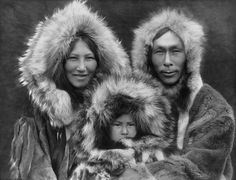
Early-contact-period Eskimos are typically portrayed in Western literature as having been happy, peaceful, honest, smiling people who were friendly toward strangers. Alaskan Eskimos, however, described their ancestors to me as having been quarrelsome and warlike, and they supported that general view with numerous accounts of specific raids and battles.1 – Ernest Burch, Jr.
When people think of Eskimos they think of a gentle group of innocent people minding their own business. Ernest Burch, Jr, a noted researcher and anthropologist of the subarctic region differed. He had studied the indigenous peoples of Alaska over a 50 year span and concluded that like many indigenous people, the Alaska natives engaged in large amounts of conflicts and had strong animosities toward neighbors. Burch contributed a chapter in North American Indigenous Warfare and Ritual Violence, authored by Richard Chacon and Ruben Mendoza, describing conflicts between the native Eskimos and the Athapaskan people.
Historically, the Alaskan Eskimos lived on or near the western coast of Alaska. They comprised primarily of the Inuit and the Central Yup’ik peoples. The Athapaskans bordered the Inuit and the Yup’ik people to the east. They comprised of the Gwichin, Koyukon, Tanaina, Deg Hit’an, and Holikachuk people.
The Eskimos and the Athapaskans had engaged in high amounts of violence up until the 1830s. At that time they gradually became civilized and pacified upon European contact. Most of the reported conflicts of the Alaska indigenous people were Eskimo on Eskimo violence, though some were between the Eskimo and the Athapaskan people. Like many indigenous people, the Alaskan natives were highly tribal and defensive. Historically, the main reasons for violence among heathen people has simply been revenge. The Alaska natives were no different.
When the Alaskan indigenous people engaged in conflict, the goal was to kill as many of their opponents as possible. Women and children were not excluded. Because the Alaskan natives had resided in the same region for over 2000 years, they had plenty of grudges to draw upon whenever a source of tension sparked. In this remote part of the world, the population density was low. Leadership and specialization among the groups were weakly developed. Every able boy and man was expected to fight and defend when the situation arose. Customarily, raids and attacks resulted in the winning side making an attempt to kill all opposing combatants, save one. This sole survivor would be instructed to go back home and tell their people what had happened, as a warning to not mess with them again.2
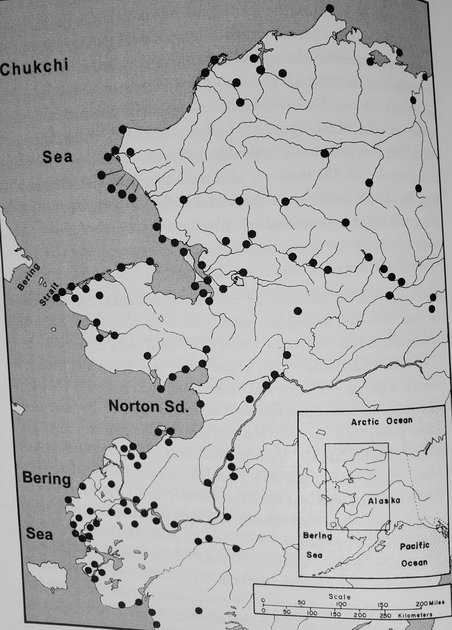
Indigenous raid and battle sites. From North American Indigenous Warfare and Ritual Violence
The surprise attacks was one of the three main types of attacks utilized among the Alaskan indigenous people. The others were open battles and terrorist acts. Of the surprise attack, the most common tactic was the nighttime raid, when the residents were asleep. These were among the most frightening of all attacks. They were usually undertaken by one to two dozen men during the fall, when the nights were longer but the snow-pack relatively light. Burch describes the situation:
The general procedure of the nighttime raid was for the members of the attacking force to sneak into a settlement when its residents were asleep in their houses or enjoying some kind of festivity in the kashim (community hall). The objective was to catch everyone inside the buildings and block the doors. Torches and flammable material were then dropped into the buildings through the skylights. After the fire and smoke had had sufficient time to build up, the door was unblocked, and the people inside the building had the alternatives of staying inside and suffocating or burning to death, or trying to escape and being clubbed or speared to death.
If surprise was complete, and if everyone in the target settlement was trapped inside a blockaded building, a nighttime raid could be devastatingly effective. Everyone in the target settlement would be killed. In the Y-K Delta, where the men and older boys slept in the kashim raiders sometimes contented themselves with investing it and restricting their killing to the men inside. They might rape a few women and steal a few things, then leave. Alternatively, they might kill everyone and they frequently set many of the buildings on fire.3
Burch describes one surprise attack when a party of upper Kobuk River Koyukon encountered the upper Noatak River settlement of Makpik. The active male inhabitants of Makpik were off on a hunting expedition some distance away. This gave the chance for the Koyukon to make a surprise attack on the village.
The raiders waited until the hunters had gone, then made a daylight raid on the settlement, killing all of the elderly men and children in the camp and all of the women except two, whom they took as captives.
If a raid was a failure, the defenders attempted to annihilate the entire attacking force—save one. That one was given some food and any necessary first aid and was sent home with instructions to tell his countrymen what had happened and to warn them never to attack the victors again.
Though the focus was on the Alaskan Eskimos, this could more or less be applied to Eskimos in general, as they also resided in Canada, eastern Siberia, and Greenland. The Copper Eskimo (Inuit) lived in the Kitikmeot region of present day Northwest Territory of Canada. Their name was given by the English settlers because they relied on copper gathered along the Coppermine River. Lawrence Keeley in War Before Civilization: The Myth of the Peaceful Savage, disclosed that:
The Copper Eskimo, experienced a high level of feuding and homicide before the Royal Canadian Mounted Police suppressed it. Moreover, in one Copper Eskimo camp of fifteen families first contacted early in this century, every adult male had been involved in a homicide. Other Eskimo of the high arctic who were organized into small bands also fit this pattern. Based on figures from different sources, the murder rate for the Netsilik Eskimo, even after the Mounties had suppressed interband feuding, exceeds that of the United States by four times and that of modern European states by some fifteen to forty times. 4
Louis Bird, a Cree Indian elder, describes an incident that occurred on the Hudson Bay settlement, Cape Henrietta Maria in present-day Ontario, involving the Inuit:
(This) was a long time before the European came into the scene. And there was no guns and other European trade goods. And this raid from the Inuit warriors attacked the group of Omushkegok people, mostly women and children and the elders, while the men were hunting … the Inuit descended from their hiding place and attacked the camp, killing all the elders and the children and women. And also being so excited by killing, they begun to act very strangely and very savagely which led them to cut the breast of the women who were … nursing the children. 5
Though there may have been some exaggeration in the narration of the above account, provided that it came from a rival of the Inuit, this similar story was confirmed by Nicholas Jeremie, a settler who worked at a trading post on Hudson Bay early in the eighteenth century.
James Knight, a Hudson Bay Company trader, discloses:
“Them Natives to the Norward [of Churchill, Manitoba] are more Savage and brutelike than these [Chipewyan] and will drink blood and eat raw flesh and fish and loves it as well as some does Strong Drink”. Confirmation that the Inuit were not to be trusted came in 1719 when Knight, who left Churchill in two ships on a voyage of discovery to the north, never returned. The remains of the ships were discovered in 1722 by Captain John Scroggs, who reported that “every Man was killed by the Eskemoes”. 7
Though I’ve discussed violence committed by the Eskimos, when it came to relations with the Cree Indians in the Hudson Bay region of Canada, the Eskimos were more often than not the victims. The Crees, though usually at peace among their own people, took out revenge and frustration against non-Cree groups. The Crees believed that every calamity and misfortune experienced by their people was somehow caused by an outside group. Should one of their members suffer from an illness or should they have had a bad hunting season, the Crees avenged their losses by attacking a rival group as they believed they were a sign of misfortune. The Eskimos were their favorite target. Andrew Graham, who lived in the Hudson Bay region from 1749 to 1791 remarked:
There is such enmity between the Indians and Esquimaux, that the former have massacred all of the latter within their power. There is a grand ceremony in which every warrior eats a bit of an Esquimaux, about the size of a nutmeg, and raw. 8
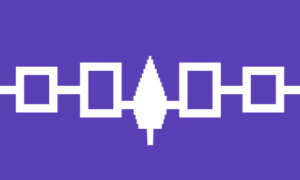
History books usually depict Indians as gentle people who valued nature and human beings and only became violent upon European contact. However, archaeological records and documentation by European settlers has consistently indicated otherwise. Dean Snow, who authored Iroquois-Huron Warfare in Chacon’s book, makes this point bluntly:
There, as elsewhere in North America, no evidence exists to suggest that American Indians lived in peaceful harmony before European colonization. 9
The Iroquois Indians, who resided in present-day southern Ontario and upstate New York, had a reputation for violence ever since their first encounter with European settlers. In fact “Iroquois” means “killer people” in late 16th century Basque etymology.9 During the 16th century, five Iroquoian tribes, the Mohawks, the Oneidas, the Onondagas, the Cayugas, and the Senecas, consolidated their powers and established a confederacy referred as to the League of the Iroquois. The League went to war with virtually all of their neighbors. They eliminated the Hurons, the Petuns, the Neutrals, and the Eries from the region by the mid-17th century.
Like the Cree people described above, the Iroquois also believed that mishap and misfortune in their lives were somehow caused by a distant enemy group. A family member dying prematurely or even an elderly parent dying of cancer, had to be avenged with death. In the eyes of an Iroquois someone was to be held responsible. This cycle of death and revenge ensured that violence among these groups of people went on in perpetuity. It was said that among the Iroquois, war was the norm and peace the exception. The Iroquois, like many Indian tribes, did incorporate captive enemies into their own society given that they pass a torture test. However, as Keeley indicates below, sometimes captives were never given a second chance:
A few cultures occasionally took men captive only to sacrifice them to their gods or torture them to death later. Among the Iroquoian tribes of the Northeast, captured warriors were often subject to preliminary torture during the return journey of a war party. When the party arrived at the home village, the prisoners were beaten by running the gauntlet into the village. At a council, the warrior prisoners who survived these initial torments were distributed to families who had recently lost men in warfare. After these prisoners were ritually adopted and given the name of the family’s dead member, they were usually tortured to death over several days. The victim was expected to display great fortitude during these torments—taunting his torturers and expressing contempt for their efforts. When the prisoner was dead, some parts of his body were eaten (usually including his heart) by his murderers. 11
Speaking of cannibalism, documentations exists that the Iroquois ate some their enemies. Thomas Abler corresponded a refutation of W. Aren’s The Man-Eating Myth, titled, Iroquois Cannibalism: Fact Not Fiction. His documentations drew upon Dutch, French, and English accounts.
The Jesuits have graphically described the butchering of bodies in preparation for eating. Skinning human remains for “a detestable repast” is noted. Another priest saw two “drunkards” skin a thigh, after which one left the house and “reentered the cabin with the liver in his hand”. 12
Another captive’s account described that, “In the presence of the christian woman, they crushed all his fingers with their teeth; They cut off half of one hand, and they bit off his ears, which they at once swallowed, quite raw”. 13
René de Bréhant de Galinée, a French missionary to the Native Americans in the 17th century reported that his men were: “barbarous enough to wish to see the torture . . . from beginning to end” in a Seneca village. The end involved butchering the captive and feasting on him. “Several presented portions of his flesh to the French, telling them there was no better eating in the world”. 14
These barbaric practices largely disappeared during the 18th century after the Iroquois became Christianized.
The Indigenous People of the Northwest Coast
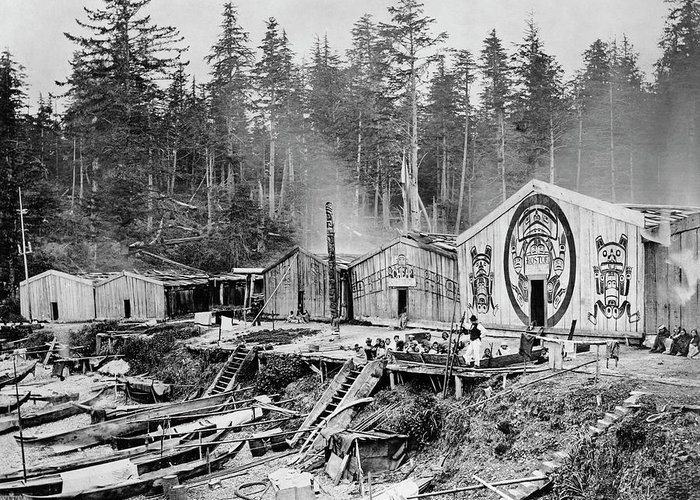
The indigenous people of the Northwest coast were a group of Indian tribes that stretched from Puget Sound in Washington state, across coastal British Columbia, and to Yakatat Bay, Alaska. The southern part of the region was primarily comprised of sedentary tribes with permanent villages. The Salish tribe represented such people. The northern part of the region were mainly hunter-gatherers and were represented by groups such as the Tlingit and the Haida people. The Northwestern groups practiced human sacrifice, slavery, and revenge killings.
As mainly nomadic people, the northern groups oftentimes raided the more settled groups for resources. Among things raided were food, clothing, women, and slaves. The south, however, with it’s more complex and organized societies were primarily concerned with preserving what they had and built. They were mainly concerned with defense. As you can imagine, conflicts were frequent between the raiding nomadic people and the settled people.
The use of slave labor has always been an important part of indigenous Northwestern life. However, it’s use escalated upon contact with the European settlers after the 1830s. Slaves were traded to the settlers (and to other tribes) in exchange for food, clothing, and firearms. The groups that held the most slaves were considered the most warlike. The northern groups tended to own more slaves than the southern groups. However the Kwakiutl, which was situated between the northern and southern regions owned the highest median number slaves by 1850.11 The settlers took the slaves, not to use as labor, but to prevent the Indians from killing them off.
The Northwest Coast groups believed in a form of spirituality that cherished revenge killing of enemies through warfare. Festivities such as the Winter Ceremonial was an important event for the Kwakiutl people that celebrated the spirit of war and death.
The Winter Ceremonial contained the important Kwakiutl military themes such as killing enemies, destroying property, ritual antagonism between rivals from different secret societies, burning houses, and the taking of trophy heads and scalp’s.
The historical record indicates that predatory raiding circa 1830-50 likely contributed to an elaboration of the Winter Ceremonial characterized by the killing of slaves, aggressive property distribution, and ritual cannibalism, particularly after 1835 when an elite Kwakiutl war party attacked the Heiltsuk (Bella Coola) and acquired the rights to perform the Aamatsa, or cannibal dance. 12
By the 1860s, slave holding and warfare was on a sharp decline as the people became more civilized.
The Winter Ceremonial of 1859-60 may have been the last one to use human sacrifice in the form of trophy heads and slaves. After the mortality wrought by smallpox in 1862, the Winter Ceremonial changed. Sacrificing slaves was replaced with coppers, which were made from the copper sheathing of European ships and first observed in use by the Kwakiutl in 1866. The Winter Ceremonial was the only ritually appropriate occasion to break or destroy a copper, an act that mimicked the destruction of a human body. 13
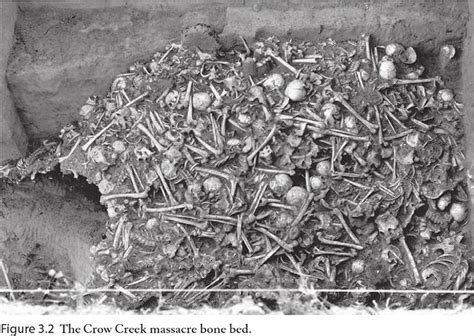
The Crow Creek massacre in present day South Dakota took place in the 14th century. At this site, archaeologists have counted nearly 500 remains. The Caddo and the Siouan-speaking people had occupied the site. It was thought that all people at this site were killed during the attack.
There, perhaps at dawn on a winter day in the early AD 1300s, raiders virtually decimated the population of a large fortified village. The mutilated bodies of nearly five hundred villagers were recovered in our excavations, with more bodies known to exist in the makeshift grave and in the site’s burned houses. This truly was a massacre rather than a battle; most villagers appear to have been clubbed to death while fleeing. There is not an embedded arrow point in any of the bodies. Men, women, and children were indiscriminately killed. Their noses, hands, and feet were sometimes cut off, teeth smashed, and heads and limbs cut from the body. The victims, from babies to elders, were universally scalped and mutilated. The scale of the deaths suggests that most of the inhabitants were killed. 14
From the archaeological records, it is postulated that the victimized group were weak and suffered from poor health and diet, perhaps as a result of losing important members of their society to previous conflicts. They were an easy target.
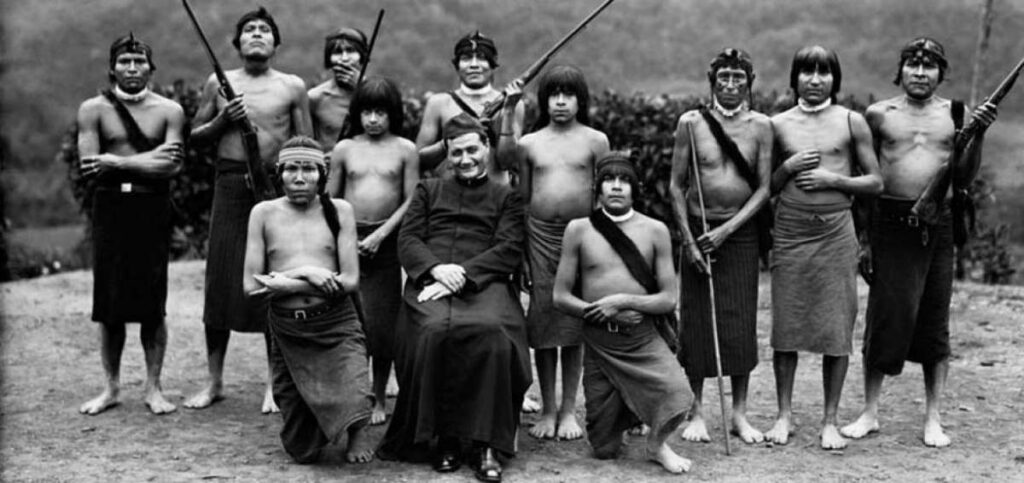
The Achuars were a tribe that resided in the northern Amazon rain-forests of Peru and Ecuador in South America. They were one of the last groups of people on earth unaffected by the outside world. The Achuars were highly territorial and were extremely suspicious of outsiders. In The Society of Nature (1994), French anthropologist, Philippe Descola, devoted an extensive study of the Achuar people and their environment. He disclosed that:
Achuar society lives in a perpetual state of war, and it is no doubt significant that their vocabulary has no term for peace; daily life swings between times of out-and-out warfare and periods of latent hostility. This endemic feuding has important demographic consequences, since something on the order of one out of every two male deaths can be attributed to war, as compared to one in five for women. 15
The arrival of Christian missionaries from America attempted to transform Achuar society. Though missionary activity in the region had been present since the 1940s, it wasn’t until twenty years later that missionaries made real inroads. Though the Achuars have become more accepting of outsiders due to Christianity’s pacifying effects, violent outbreaks between Achuars and outsiders still occur. There have been a number of violent encounters between them and the oil developers since the mid-1960s. The aggressiveness of the Achuars have made it difficult for them to drill on their land.
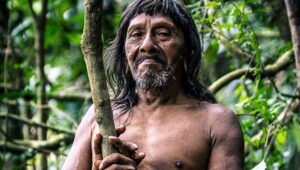
The Huaoranis, also known as the Waorani people, were once regarded as among the most violent people on earth. As Ecuador’s “last savages”, colonization of them has been difficult. The Huaorani tribes still exist today, more or less continuing their traditional ways of life, albeit being reduced in number as their population faces pressure from land developers and big oil. They are a group of hunter-gatherers who have traditionally never relied on agricultural. As highly tribal people, the Huaoranis have a strong in-group, out-group barrier. Life centers around the “longhouse” where up to 25 Huaorani family members live and congregate. Huaoranis believe their ancestors created the earth and all life forms on it.
“Huaorani” literally means ‘true human beings’ as opposed to “cohuori” which refer to all other people. Cohuoris are viewed as half-humans, half-animals that prey upon Huaoranis to suck their blood and eat them. In other words cohuoris are seen as cannibals. Cohuoris can refer to a rival tribe, a raiding army, or colonizing settlers. Huaoranis live in their own little world and always believe themselves to be victims in their struggle with the cohuoris. Huaoranis never see themselves as predators, even when they instigated the conflicts. However, unlike other tribal people, the Huaoranis did not take the victim’s possession after they killed them. They did not scalp their heads or take body parts as trophies. Nor did the Huaoranis take women or children as captives. They did not want any association with the cohuoris or their possessions.
What really separated the Huaoranis from other tribal people was the way they dealt with death. A kin that dies prematurely, whether it be by natural disaster, disease, or through accidents, caused men to experience a state called pï ï or “homicidal furor.” This is a condition of extreme emotion that makes the subject go on uncontrollable killing sprees and avenge against perceived enemies. The Huaoranis viewed premature deaths as an insult. While many heathen groups, such as the Iroquois and Crees, mentioned above, would avenge premature natural deaths by raiding remote tribes, the Huaoranis often targeted their very own people. Not even death at the hands of a cohuori would produce pï ï. In the the eyes of a Huaorani, being killed by a non-Huaorani was little different than being killed by an animal. After all they didn’t distinguish between the two. This type of death was seen as natural, while actual natural deaths, such as caused by disease and natural disasters, were considered unnatural. Laura Rival, an anthropologist who has studied the Huaorani over a multi-year period, discloses in Trekking Through History: The Huaorani of Amazonian Ecuador:
I witnessed men becoming piï on several occasions. Each time, the first manifestation of rage was directed against the man’s young children. His wife or wives and other co-residents had to contain him, stop him from seizing his spears and killing in his own house. Once I heard a man, infuriated by the death of his son who had drowned in the Curaray River, sing: “I want to kill, as a result you die. My becoming angry drives me to want to kill, resulting in your dying.”
After the first fit of rage, men usually channel their piï energy by planning a killing raid. Their rage and determination to kill, which they sustain through chanting, spreads contagiously to other men in the longhouse. They need to remain in a state of rage throughout, from the fashioning and decorating of spears to the finding of and spying on victims. Victims are ambushed and killed when they are most vulnerable or least suspicious. 16
Huaoranis engaged in pï ï took their long spears and thrusted them into their victims abdomen while pushing and pulling through the organs to cause large amount of bleeding. This type of death is normally slow and painful. Though the victim usually dies before help arrives, in some cases they are discovered alive by their relatives. In this case, the loved ones hastily sets up a grave to bury the victim alive, in order to minimize suffering. In addition should the victim have children, they take the youngest child and bury him or her alive with him. This was done to make sure that the victim does not become lonely in his afterlife.
American evangelical missionary activities beginning in the 1950s helped pacify the Huaorani people to some extent. The Christian fundamentalists ardently pushed for monogamy, praying, and sexual modesty, while discouraging feasts and dancing.17 The missionaries faced some difficulty when five of their members were speared to death in January 1956. Not discouraged, the missionaries have kept pushing on. While evangelists believed themselves to be on a moral mission “sent by God” to tame and civilize one of the last “savages” on this planet, anthropologists on the other hand saw their activities as destroying one of the last unique indigenous cultures that remain.
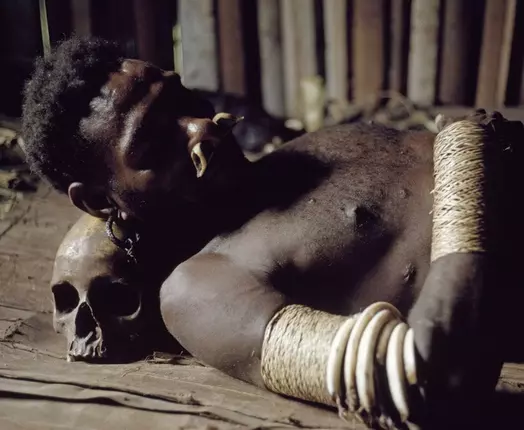
New Guinea man uses enemy skull as pillow in 1962
New Guinea is a large island located in Oceania in the southwestern Pacific Ocean. The territory is divided into two – Western New Guinea and Papua New Guinea. New Guinea is host to hundreds of different tribes and languages. One particular area, the eastern highlands region of Papua New Guinea was long known for endemic tribal violence, more so than the western highlands region. The highland Papuans were strongly ethnocentric people. In the eastern highlands, violence was not only directed to other men, but also towards women and children. Headhunting and cannibalism was rife. This practice, however, had largely ceased by the late 20th century. D.K. Feil, in The Evolution of Highland Papua New Guinea Societies, discloses:
The archetypal cases for Lewis Langness (anthropologist who had studied indigenous New Guinean culture extensively) of ‘unrestricted warfare’ are the Gahuku-Gama and Bena Bena of the eastern highlands. For the former, ‘In warfare the aim is the complete destruction of an enemy and his means of livelihood, and each single tribe is opposed to other tribes which are regarded as traditional enemies and consequently as being permanently “at war” with one another’ Similarly in Bena Bena, ‘the stated aims of warfare were the complete and total destruction of the enemy if possible. This included every man, woman and child, whether old, infirm, or pregnant. Although it is true that most raids resulted in only one, or few deaths, cases were known in which entire groups were destroyed’. 18
Lawrence Keeley on Papua Guinea warfare:
When a Mae Enga warrior was seriously wounded by an arrow or a javelin, his adversaries would charge forward to chop him literally to pieces with their axes. 19
The Tupi people were one of Brazil’s largest group of indigenous people. Formerly from the Amazon rain forests, the Tupis occupied nearly the entire length of Brazil’s coast. Brazil’s other major group was the Guarani, who lived inland. The practice of cannibalism had been documented by Portuguese settlers during the 16th century:
According to primary source accounts by primarily European writers, the Tupi were divided into several tribes which would constantly engage in war with each other. In these wars the Tupi would normally try to capture their enemies to later kill them in cannibalistic rituals. The warriors captured from other Tupi tribes were eaten as it was believed by them that this would lead to their strength being absorbed and digested; thus, in fear of absorbing weakness, they chose only to sacrifice warriors perceived to be strong and brave. For the Tupi warriors, even when prisoners, it was a great honor to die valiantly during battle or to display courage during the festivities leading to the sacrifice. The Tupi have also been documented to eat the remains of dead relatives as a form of honoring them. 20
Lawrence Keeley on the treatment of Tupi captives:
(Harsh) treatment was inflicted on captives by various Tupi groups in South America; in some tribes, the tortured prisoner was dispatched by children using arrows or axes, and the boys’ hands were then dipped in the victim’s blood to symbolize their duty to become warriors. 21
The Catholic missionaries during the 16th century worked hard to pacify the Tupis. They banned cannibalism. Many Portuguese men who settled in Tupi territory married Tupi women, since the colonists brought few Portuguese women. The settlers also made extensive use of Tupis as slave labor and many of them died from being overworked. However it was disease from the Europeans that did the most damage as it wiped out nearly the entire Tupi population.
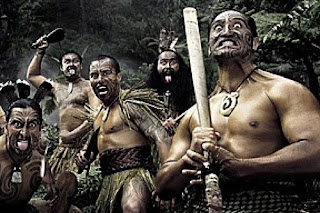
The Maoris were the indigenous people of New Zealand. They arrived from eastern Polynesia during the 14th century. During their time in New Zealand, the Maoris hunted the moa and other indigenous flightless bird to extinction as they exploited the land.22 There were roughly 40 Maori tribes in New Zealand during the late 18th century and their population numbered 100 to 300 hundred thousand. They were the sole people of New Zealand until European contact. Though the individual Maori tribes were similar to each other, they warred very frequently with one another. Like many heathen people, the Maoris’ primarily used violence instead of diplomacy to settle disputes. Their use of violence was mainly driven by revenge, as documented by Andrew Vayda in War in Ecological Perspective:
Maoris were strongly motivated to pursue policies of retaliation rather than non-retaliation. Suffering injuries meant to them a spiritual as well as a physical weakening and, accordingly, required the injured to strive to heal themselves by deeds that would restore their repute, their courage, their feeling of strength and wholeness. This way of thinking about injuries and about the necessity for avenging them is said to have been among the first lessons taught to Maori children. By the time the children were grown, they regarded revenge a vital point of honor and one of the most important duties of man-something to be pursued in spite of danger, difficulty, and every fatigue and privation. The ideas about revenge were what Gregory Bateson would call “hard-programmed”: they were deeply ingrained and were accepted, without critical inspection, as a basis for other ideas and action. 23
A Maori group would revenge not only against other Maori groups that practiced violence against them but even against groups that merely taunted and insulted them. Maoris also expressed hatred against their foes by eating them. A New Zealand missionary once heard a Maori warrior taunt the preserved head of a slain enemy:
You wanted to run away, did you? but my meri [war club] overtook you: and after you were cooked, you made food for my mouth. And where is your father? he is cooked:—and where is your brother? he is eaten:— and where is your wife? there she sits, a wife for me:—and where are your children? there they are, with loads on their backs, carrying food, as my slaves. 24
Samuel Marsden, a leading missionary member in New Zealand, during the early 19th century, echoes a similar situation:
“If any chief falls into the hands of a tribe which he has oppressed and injured by the chance of war, they are sure to roast and eat him; and after devouring his flesh, they will preserve his bones in the family as a memento of his fate, and convert them into fish-hooks, whistles, and ornaments. The custom of eating their enemies is universal. The origin of it is now too remote to be traced. The natives generally speak of it with horror and disgust, yet they expect that this will be their own fate in the end, as it has been with their forefathers and friends. I represented to them how much their national character suffered in the opinion of all civilised nations from this horrid custom. Many regretted that it should be the practice of their country, and said that when they knew better they would leave it off. If the head of a tribe is killed and eaten, the survivors consider it the greatest disgrace that can befal them; and in their turn they seize the first opportunity to retaliate.” 25
In 1642, Abel Tasman, a strongly suspected Jew, who worked for the Dutch East India Company, was the first European to set foot on New Zealand. However, European settlers (known as Pakehas) didn’t start settling in number until the latter half of the 18th century. The introduction of firearms into Maori culture completely changed the way Maori conflicts were conducted. The settlers courted Nga Puhi’s (a Maori tribe) leader, Hongi Hika, as he was eager to do favors for them in exchange for muskets. Hongi worked with the Pakehas and helped missionaries establish a foothold, even though he himself never converted to Christianity. Hongi was brought to England and then to Australia to learn Western customs. Back home he helped protect settlers and missionaries from Maori violence. Hongi worked with the missionaries in developing a written language for the Maoris, which would help spread Christianity by making them literate in the bible. He donated thousands of acres of land to churches. Despite the services he provided, Hongi admitted that Christianity was a “religion fit for slaves.”
With the newly acquired muskets from the settlers, the first thing on Hongi’s mind was avenging against his enemies. What appeared to be a pleasing and mild mannered man when visiting England, became a vengeful monster upon his return home. He and his 2000 men with 1000 muskets planned on a murder spree across the entire island. He avenged for the death of his father and sister. Hongi and his men avenged for previous humiliating defeats against the Ngati Paoa, Ngati Maru, and Waikato by killing thousands of men, women, and children. The heads of the killed chiefs were hung on poles while some of their victims were eaten. The clubs and spears of the rivals were no match for Hongi’s firearms. Just their racket was enough to scare them into submission. But in time, his enemies too acquired them. And soon just about every Maori tribe were equipped with muskets. Firearms however were like alcohol and cigarettes. They were addictive and had a costly toll on the people at the end. Not just in terms of lives lost but on the resources that had to be given up for them. They reduced the people to servitude26 as the Maoris traded away their goods to the settlers for arms. The Maoris sacrificed enormously to acquire just a single weapon as Pakeha, F.E. Maning, who lived with the Maoris, put it: that for one or two muskets the people had to give a ton of flax, “scraped by hand with a shell, bit by bit, morsel by morsel, half-quarter of an ounce at a time.” Maning continues:
Now as the natives, when undisturbed and labouring regularly at their cultivations, were never far removed from necessity or scarcity of food, we may easily imagine the distress and hardship caused by this enormous imposition of extra labour. They were obliged to neglect their crops in a very serious degree, and for many months in the year were in a half-starving condition, working hard all the time in the flax swamps. 27
Missionaries were stunned by the Maori violence. However it was not just violence but disease, brought by the Europeans, that killed Maoris. It was estimated that between one-quarter and one-half of the Maori population was lost during the early 19th century. Up to that time, missionary activities had been largely unsuccessful in converting the stubborn Maoris. The Annual Report of the Wesleyan-Methodist Missionary Society stated that in 1830, seven years after their mission began, ‘the perverse levity and awful depravity of these savages appear to be unequalled in the history of man’.28 But by the 1830s, the Maoris started to question whether fighting for revenge was really worth the sacrifice of lives. When the missionaries started to learn and speak Te Reo, the Maori language, conversion came much easier. By the 1840s the Maoris started converting to Christianity in numbers and became more civilized. However, by the 1860s, a different type of conflict developed. Instead of Maori against Maori, it was Maori against settlers. They had started to pour in large numbers and the Maoris found their territories shrinking. The settlers had won out at the end. Looking back at history, there are some that applaud the missionaries for civilizing the once barbarian people, but there are others that criticize them for destroying ancient indigenous cultures.
Ironically, some Maoris started to take the religious teachings that was intended to pacify them, spin them around, and use it as a weapon against the Pakehas. Several Maori fringe movements, based on the bible, sprung out in response to what they saw as hostile Pakeha takeover. The most well known was the Pai Mārire movement, led by the prophet Te Ua Haumēne. The movement started to flourish on the North Island from 1863 to 1874.29 Pai Mārire took themes from the bible and incorporated Maori elements in it. The Maoris saw themselves as the “second chosen people” and believed that Jehovah would fight for the Maoris and drive the Pakehas to the sea. The settlers saw Pai Mārire as an extremist movement and worked hard to suppress the religion and persecute the followers.
The Naga People of Northeast India
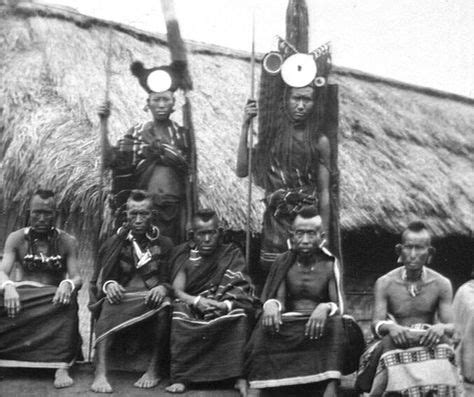
The Nagas were a group of oriental tribes that originated in the hills of the northeastern section of India near the Nepal border. In this section of India was the Assam, Manipur, and Arunachal Pradesh regions. It was said that before Western contact, the Naga people of Assam, “have as many wars as there are hairs on a Naga’s head.”30 Perhaps an exaggeration but it nonetheless illustrates the high amount of feuding the tribes had against one another.
William Smith in, The Ao Naga Tribe of Assam, explains that the most serious Naga casualties were not the result of actual battles, but from the surprise attack and ambushes that caught the victims off guard: The worst feature of this warfare was that helpless women and children were slain without any compunction; and the man who slew a child was held in the same esteem as one who had smitten his Goliath of Gath. 31
Headhunting was a widespread practice among many Naga groups. Collecting the heads of enemies, especially of chiefs, and displaying them demonstrated honor and bravery. A man who was ready to marry must bring home heads to earn respect from women. Headhunting was also seen as a spiritual undertaking and pleasing to their god, Lizaba. Headhunting raids were not limited to attacks on men. Smith quoting Sir J. Johnstone:
“To kill a baby in arms, or a woman, was accounted a greater feat than killing a man, as it implied having penetrated to the innermost recesses of an enemy’s country, whereas a man might be killed anywhere by a successful ambush.” 32 33
The Ao Nagas worshiped many gods but it was thought that there were no images of them. Like many heathens, they were intensely superstitious. Nago life changed literally overnight when missionaries arrived from Britain and the United States during the late 19th century. When the first missionary, Mr. Clark, introduced firearms to the Nagas by felling an elephant with one shot, they were awestruck. The Nagas valued the gun more than anything else that the colonizers brought and like the Maoris mentioned above, would trade anything to get them. Under Christian colonization, both headhunting and slavery stopped. Farmers no longer had to go out in the field armed while worrying that their wives and children could be massacred at any moment. Promiscuity and vulgar conversations among the Nagas started becoming taboo while prayer and abstinence became more of the norm. At the big annual sacrifices, cattle were customarily killed in a cruel manner of being hacked to pieces while it bled to death. This was gradually phased out. Though the Nagas became more civilized, their old traditions and culture largely disappeared. 34
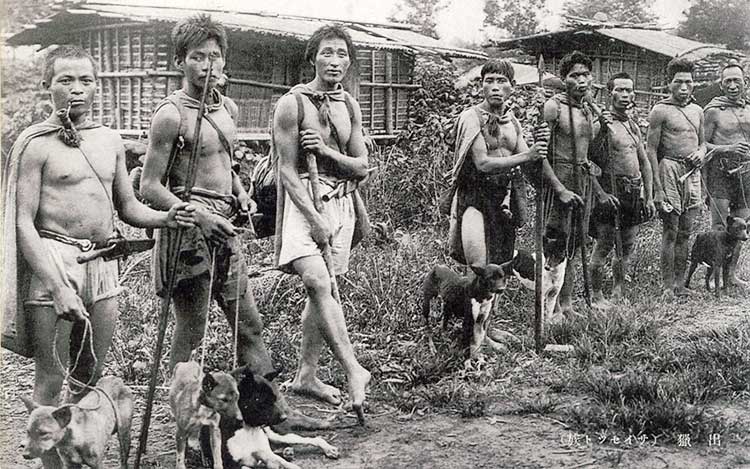
The Formosan people are Taiwan’s indigenous people. Research suggests that they have been in Taiwan for approximately 6500 years. Formosans number approximately 800,000 or 3 percent of the country’s population. There are 26 recognized languages of the Formosans. They are considered Autronesian people and are related to the Polynesians.
The Formosans were made up of many different groups and within each groups were several subgroups. Formosan groups and subgroups would frequently conflict with one another. They practiced headhunting extensively. When young boys reached the age of maturity, he was to celebrate this by going on his first headhunting journey.34 The young warrior was usually accompanied by several boys who were around his age and were also going on their first expeditions. This group was led by experienced male headhunters. Securing the head of an enemy was seen as appeasing the gods and cultivating the soul. A great feast was prepared when a warrior returned with one or more heads.
At the time of feasting and dancing in celebration of a victory, head of the victim is placed on “the skull-shelf ” of the village — being often the last addition to a pile of others — and food and millet-wine are placed in front of it, food being sometimes inserted into its mouth. The chief (often a woman), or high-priestess, of the village offers to the last-decapitated head an invitation to the following effect warrior, you are welcome to our village and to our feast! Eat and drink, and ask your brothers to come and join you, and to eat and drink with us also.” This invocation is supposed to have a magical effect in bringing about other victories, and thus adding more heads to the skull-shelf. 35
This practice went into decline when Taiwan was being colonized by a host of foreigners. From the 17th to the 20th centuries, the Formosans were under the influence of the Dutch, the Spaniards, the Chinese, and the Japanese. During the 17th century, Christian missionaries, under the auspices of the Dutch East India Company, arrived in Taiwan. They worked hard in civilizing the Formosans in attempt to end their barbaric practices of headhunting and enemy raids. The priests intermarried with the locals, which irritated the Formosans. This civilizing process made it much easier to extract resources from the Formosans and make them players in global trade. The Dutch were particularly attracted to the prospects of finding gold.
One of the controversial things the missionaries had done to the Siyayans (a Formosan tribe) was persecuting their Inibs. Inibs were women that communicated with the divine world through ceremonies and shamanistic rituals. They were highly respected in their communities. Women in Formosan society in general were held with high esteem.36 However in the missionaries’ eyes, the Inibs were the most prominent symbol of paganism in Siyayan society and were a great obstacle in conversion of the masses. Because of this, the missionaries excommunicated the Inibs by banishing them from their communities and forcing them to live in isolation.
Mass conversion of the Sirayan took place between 1636 to 1639 among villagers in the south-western plains under Dutch compulsion. It was reported that the inhabitants of the Tavocan village burned their idols under the presence of minister Robertus Janius. The same thing happened in Soulang and Mattauw under Governor Johan Van der Burch and a pair of ministers. So impressed by the success of the conversions, Van der Burch written,
“It is impossible for me to refrain from praising the docility and tractability of these folk; they are so easily governed.” 37
The Dutch were not the only foreigners pushing their religion on the Formosans. During the Zheng and Qing eras, oppressive Hans brought Taoism and Buddhism in. But despite the work of missionaries, some Formosan groups held stubbornly to their ancestral beliefs. Headhunting was still being practiced by the Taiyal, the Paiwan, and the Bunan tribes at the turn of the 20th century. By 1930, this practice disappeared altogether under Japanese occupation.
Sparta was an ancient city-state in Greece that were at their height in power between the 6th and 4th centuries BC. Though a small group, they were among the most fearsome fighters on earth. In the Greco-Persian Wars, Sparta was the leading force in the consolidated Greek military. The Spartans defeated Athens in the Battle of Aegospotami during the Peloponnesian War in 405 BC.
The Spartans regarded fleeing the battlefield and letting their fellow comrades down as the ultimate disgrace. Famous Spartan poet, Tyrtaeos (7th century BC), invoked them to action by these words:
“…of high regard in time of war
[who] can endure the sight of blood and death,
and stand close to the enemy, and fight.
This is the highest worth (arête), the finest human prize (ariston)
And fairest (kalon) for a bold young man to win.” 38
And those who die in battle will be glorified:
Neither does his noble fame [kleos] or his name ever perish, but even though he is beneath the earth he becomes immortal [athanatos]— whoever distinguishes himself in bravery by standing stead-fast and fighting for the sake of his land and children, and is destroyed by furious Ares. 39
A fable by Plutarch, a Greek philosopher and historian, describes the toughness of the Spartan people. Spartan warriors trained for battle from an early age. At infancy, males who were deformed or deemed weak were left to die at Mount Taygetus. Spartan warriors were referred to as Spartiates and they were considered the most respected men and of the highest caste in Spartan society. The training of Spartiates was so brutal that public flogging of young trainees to install discipline was used to ingrain toughness in the warriors. Some died as a result. Young trainees were provided with scant food and clothing, which forced them to kill animals or steal food to survive.
Throughout their adult lives, the Spartiates continued to be subject to a training regime so strict that, as Plutarch says, “… they were the only men in the world with whom war brought a respite in the training for war.” Bravery was the ultimate virtue for the Spartans: Spartan mothers would give their sons the shield with the words “[Return] With it or [carried] on it!” 40
This fable below describes a youngster of seven years, the age that military training begun, that chose to die in agonizing pain than to be disgraced and dishonored for failing to live up to his duty as a warrior. This young trainee stole a fox for food, as was customary for warriors to do to survive, and rather than being caught stealing, which would have been a disgrace, chose to suffer and die instead:
When the owners of the fox came looking for it, the boys coerced one of their group to hide the fox under his tunic. But trapped inside his cloak, the panicked fox quickly turned savage, and began digging away at the boy’s flesh in a desperate attempt to free itself. The boy, however, didn’t flinch.
Not wanting to give the game away when he was challenged by his commanding officer and the fox’s owners over the animal’s disappearance, the boy remained silent and steadfast, until the entire affair had calmed down and the fox’s owners departed to continue their search. Only then did he finally drop to the ground, the bloodied fox falling from his tunic and escaping into the undergrowth.
Realizing that their fellow recruit was now dying, the boys asked him—why not just tell the truth? Surely it would have been better to let the fox go and face the punishment, rather than let it maul him to death?
“Not so,” replied the boy, according to Plutarch’s account. “Because it is better to die without yielding to the pain, rather than through being detected because of weakness of spirit and gain a life to be lived in disgrace.” 41
When many think of the Celtic people, the Irish are the first people that come to mind. Some also may have in mind the Welsh and the Scots. However the original Celts occupied a large portion of continental Europe, stretching from France to the Balkans, the Iberian peninsula, and Anatolia. There were hundreds of different Celtic tribes during ancient times.
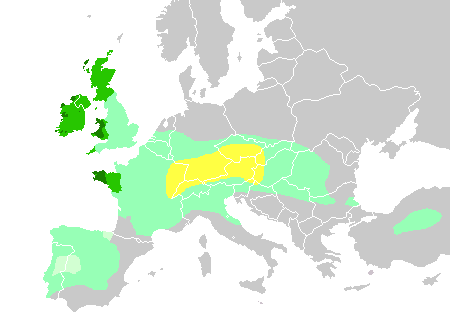
Many people picture the Celts as gentle and free-spirited people. However that was not so in ancient times. Though endemic warfare occurred regularly in many ancient societies, the Celts were particularly barbaric. Among the most controversial features, were their practices of human-sacrifice and headhunting.
Ancient Romans and Greeks recorded the Celts’ habits of embalming in cedar oil the heads of the most distinguished enemies, allies and relatives; and the mounting of the heads on walls for decoration and in porticos or pillars in their entry for display. The Greco-Roman writers also describe the Celts hanging severed heads from the necks of their horses while riding in order to intimidate onlookers and enemies alike. 42
Hanging, impaling, dismembering, drowning, slaughtering by sword or spear, and burning (holocaust) were the most common methods of sacrifice. It was said that the Celts were the worst offenders of human sacrifice, next to the Semites. The Romans, who fought against the Celts, considered them as the most barbaric people they have ever encountered. They described them as having a “cult of the severed head.”
The Celts sacrificed humans (and animals) to appease the gods or to reverse misfortune among their people. Often times during war, when facing defeat, their own weak and feeble warriors were sacrificed. Sometimes men in combat would commit suicide in hopes of bringing victory to the survivors. Children were at times sacrificed and buried in crop fields to bring in a good harvest. Sacrificed humans were even buried underneath the foundation of a new building as it was being built.
Celts were known to eat their enemies. Historian J.A. MacCulloch on Celtic cannibalism:
(Ancient Greek historian) Diodorus says the Irish ate their enemies, and Pausanias describes the eating the flesh and drinking the blood of children among the Galatian Celts. Drinking out of a skull the blood of slain (sacrificial) enemies is mentioned by Ammianus and Livy, and Solinus describes the Irish custom of bathing the face in the blood of the slain and drinking it. In some of these cases the intention may simply have been to obtain the dead enemy’s strength, but where a sacrificial victim was concerned, the intention probably went further than this. 43
Head-hunting were described in classical writings as having sacrificial purposes:
The heads of enemies were hung at the saddle-bow or fixed on spears, as the conquerors returned home with songs of victory. This gruesome picture often recurs in the texts. Thus, after the death of Cúchulainn, Conall Cernach returned to Emer with the heads of his slayers strung on a withy. He placed each on a stake and told Emer the name of the owner. A Celtic oppidum or a king’s palace must have been as gruesome as a Dayak or Solomon Island village. Everywhere were stakes crowned with heads, and the walls of houses were adorned with them. 44
The Greek writer, Strabo, described that some of the Irish even ate their parents. This was an example of what was considered “honorific cannibalism.” Keep in mind that accounts written by the Greeks and Romans may have been exaggerated, considering that they were enemies to the Celts. The Greeks and Romans themselves practiced grotesque brutality. Nevertheless, accounts by Irish writers confirm that human sacrifice did exist among the Celts in ancient times. For instance, Dindsenchas, an Irish text, describes these Celtic barbaric practices:
“the firstlings of every issue and the chief scions of every clan” were offered to Cromm Cruaich—a sacrifice of the first-born,—and that at one festival the prostrations of the worshippers were so violent that three-fourths of them perished. 45
Apparently the Romans ended those practices in Gaul by the 1st century AD.

Arguably, the Romans (along with the Greeks), were the most sophisticated and civilized among the heathens. However, their methods of punishment against criminality were quite barbaric. The execution of criminals and subversives was a public spectacle in ancient Rome. There was no better example of this than at the Colosseum. At the time it was known as the Flavian Amphitheater. For many centuries the Colosseum hosted events which featured gruesome executions of criminals and misfits in front of the public. These events were used as a public deterrent against crimes. Roman citizens who committed criminal acts were normally spared the most gruesome deaths and were usually decapitated, unless they committed serious crimes. However non-citizens and slaves were open to any number of cruel methods of execution. Some were tied naked to a pole while being eaten alive by wild animals or were forced to run around the arena being chased by a wild animal such as a tiger or a lion. Others were burned alive. In some cases the subject was to put on a decorative outfit soaked in flammable liquid. The ignition of the clothes were then ignited which made the subject dance until he died. But probably the most inhumane death was the crucifixion. Here the subject died though suffocation. This slow death lasted hours.
The most well known execution events were the gladiatorial fights. The first gladiator events were held in the 3rd century BC. Contrary to popular belief, gladiators were not sporting heroes but prisoners and criminals. These two fighters would duke it out in trying to kill one another. The winner would then face another gladiator to combat with. This cycle would continue until the last combatant. These gruesome games came under pressure from the new Christian religion beginning in the 4th century.
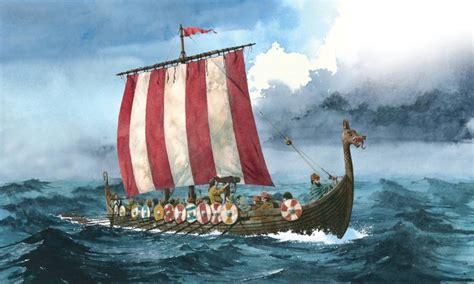
The Vikings (8th to late 11th century) were a group of people that originated from Scandinavia. They were seafarers that had a profound influence over much of northern Europe and covered a wide geographical area. They had settlements that stretched from western Russia to Newfoundland, Canada. The Vikings had a reputation as fearsome warriors. Death in battle was preferable to dying of illness and old age.
In the book Heimskringla, History of the Kings of Norway, Egil Ullserk, a warrior under King Harald of Denmark and Norway during the 10th century, wrote on the Vikings on the eve of a great battle:
“That have I feared for some time, whilst we had this long peace, that I might die of old age on the straw inside my house; but I would rather die in battle, following my chieftain. Maybe that this will now be the case.” 46
The Jomsvikings
The Jomsvikings were a legendary subgroup of the Vikings that may have resided in the northwestern part of present-day Poland in a village known as Jomsburg during the 10th and 11th centuries. The saga of the Jomsvikings was written during the early 13th century in Iceland. The Jomsvikings were dedicated to the worship of the Old Norse gods. They were an extremely tough group of fighting men who saw it as an act of cowardice to flee or surrender in battle. Jomsvikings did not go down easily in defeat. Only against vastly superior adversaries, did they walk away and only in orderly retreat. The Saga of the Jomsvikings illustrates this toughness. A group of Jomsvikings faced defeat against a rivalry led by Porkell Leira. Just before being executed, Porkell asked a Jomsviking, “How do you feel about dying?”
He answers: “I would be forgetting the laws of the Jómsvikings if I thought ill of it or complained about death or spoke words of fear. Everyone has to die once.” 47
Another Jomsviking’s response before being executed,
“I think it good to die,” says he, “with a good reputation; but yours is a life of shame, for you will live with shame and disgrace for the rest of your life.” 48
And another,
“Tell the truth, fellow,” says Porkell; “how good do you think it to die?”
“I think it good to die, like all our fellows who are losing their lives here. But I would like you to do me the favor that I should not be led to the blow like a beast, rather I wish to face it, and I want you to walk towards me from in front and strike into my face, and watch carefully to see whether I flinch at all, for we Jómsvikings have often discussed whether a man will react at all if a blow strikes him in the face.” 49
It was said that the man did not flinch at all when being hacked, except when death came upon him.
Societies before organized religion were tough and fierce. People back then were not “turning the other cheek” nor practicing Ahimsa. Neither were they retreating a foot when the enemy advanced an inch (as in Taoism). Under paganism, the gods strengthened their people, not weakened them. The pagan gods symbolized power, bravery, courage, and honor. Not humbleness, turning the other cheek, or being a lowly pacifist. Heathens preferred to fight to their deaths instead of surrendering to their enemies and risk dishonor and humiliation. This was an incredible contrast to the teachings of Christianity, Buddhism, and other organized religions. Prayers among the heathens prior to war were summoned to bring victory and to destroy foes. Ferdinand Barmadu in, Why Europeans Must Reject Christianity, explains that mercy was regarded as a sign of weakness in pagan societies:
Pity was condemned as a vice; mercy was despised as a character flaw. Mercy was viewed as the antithesis of justice because no one deserved help that had not been earned. The rational man was typically expected to be callous towards the sufferings of the less fortunate. His philosophical training in the academies had shown him that mercy was an irrational and impulsive behavior whose proper antidote was self-restraint and stoic calm in the face of adversity. In the Roman world, clementia was reserved exclusively for the vanquished in battle or the guilty defendant at trial. Weaklings and the economically disadvantaged were beneath contempt. 50
Mainstream “research” has promoted the view that primitive people before organized religion and Western civilization were peaceful until contact. However real archaeological and anthropological research has shown that to be false.
Few heathen societies were what we consider pacifist.
In one sample of fifty societies, only five were found to have engaged “infrequently or never” in any type of offensive or defensive warfare (Otterbein, K. 1989: The Evolution of War: A Cross-Cultural Study).
In another larger cross-cultural study of politics and conflict, twelve of a sample of ninety societies (13 percent) were found to engage in warfare “rarely or never” (Ross, M. 1983. Political Decision Making and Conflict: Additional Cross-Cultural Codes and Scales.” Ethnology 22)
In a study of western North American Indian tribes and bands, only 13 percent of the 157 groups surveyed were recorded as “never or rarely” raiding or having been raided (Jorgensen, J. 1980: Western Indians). 51
According to Lawrence Keeley, the few societies that seldom engaged in warfare was not because of compassionate or “moral” reasons. It was almost always due to a) being located in remote and isolated parts of the world, often the consequence of being driven out by more powerful tribes, b) being under the vassal of a centralized state, or c) simply fleeing in battles. The ones that fled battles were more likely to be nomadic and had little to lose in terms of possessions. That was unlike the settled societies which had far more to lose in terms of land and possessions and were more likely to fight head on. “Pacifist” societies were nearly always defeated tribes that couldn’t fight back or where fighting back wasn’t feasible. Even within the “pacifist societies”, homicide was common. Keeley notes groups such as the Eskimos and the Yaghan of Tierra del Fuego engaged in a high amount of inter-tribal violence.
This writeup was not to absolve modern nation-states. No doubt that modern states have committed acts of atrocities and themselves practiced brutality from time to time. We have seen that with the War on Terror, WWII, and many other wars. However, societies before organized religion almost always practiced brutality. Keeley discloses:
One author (Rhodes) has very liberally estimated that more than 100 million people have died from all war-related causes (including famine and disease) on our planet during this (20th) century. These deaths could be regarded as the price modern humanity has paid for being divided into nation-states. Yet this appalling figure is twenty times smaller than the losses that might have resulted if the world’s population were still organized into bands, tribes, and chiefdoms. A typical tribal society lost about about .5 percent of its population in combat each year (Figure 6.1 below). Applying this casualty rate to the earth’s twentieth-century populations predicts more than 2 billion war deaths since 1900.52

Figure 6.1 53
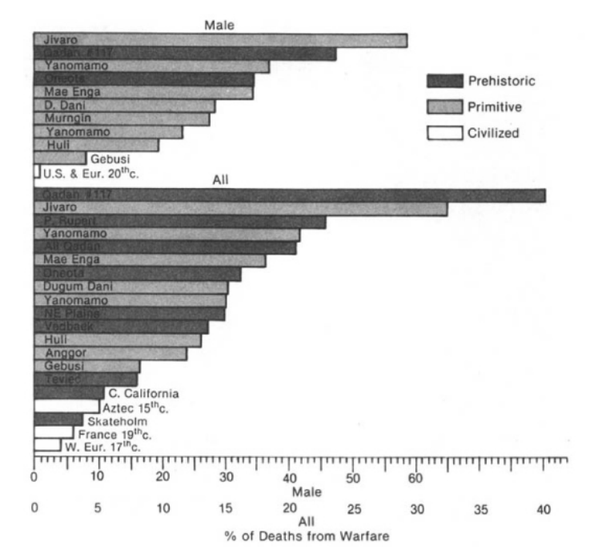
Figure 6.2 54
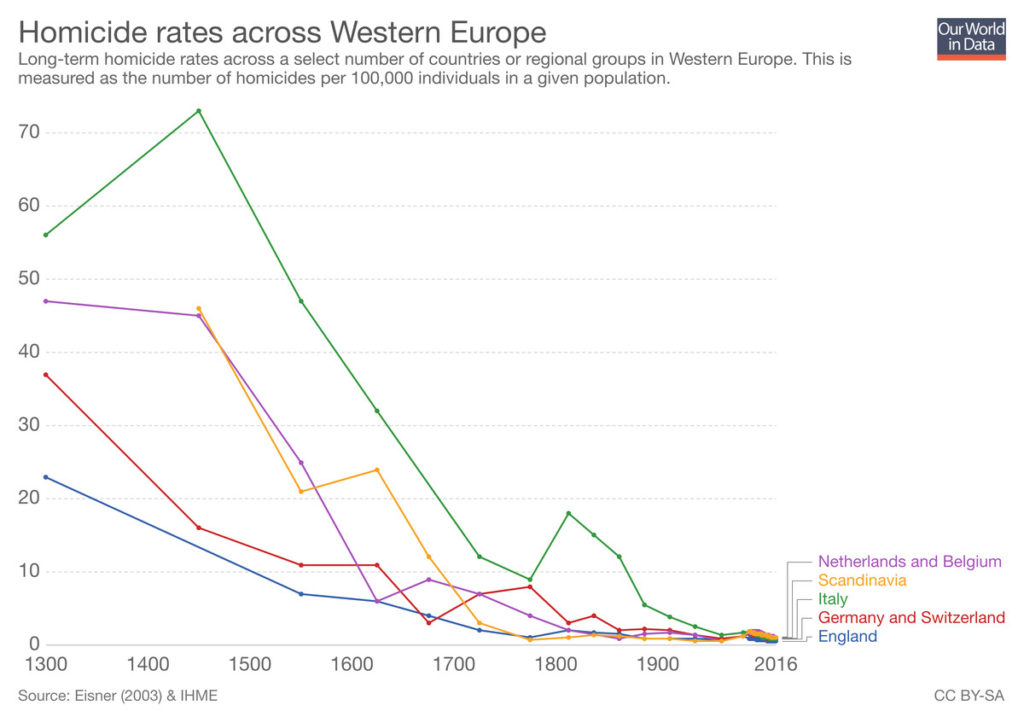
Though Western Europe has been Christianized since before the 1300s, they still hung on to their pagan ways for a while. This behavior has largely died out over time.
My writeup may have given the impression that my focus was on the barbarism and savagery among the heathens. However, my intention was to illustrate how much things have changed since those times. The heathens did have a deep sense of spiritually that bound their people together. They had a powerful connection with nature and was dependent on it for their survival. Though heathens had to constantly worry about the next conflict, they did not have to deal with today’s issues of pollution, environmental degradation, paying bills and making ends meet, finding employment, funding retirement, paying soaring healthcare costs, dealing with out of control teens, putting up with crooked politicians, etc. Most heathens were fiercely independent and provided everything they needed. There was no dependence on government and the corporations for their necessities. Many tribes were also highly egalitarian and wealth disparity did not exist. Every member made sure every member was looked over and cared for. They had a deeply ingrained sense of honesty and authenticity that has for the most part been lost.
People’s attitude towards violence back then differed little from the attitudes of people today. Heathens generally regarded war as repulsive and shameful. In just about every society in the world warriors were regarded as polluted if they had killed someone, even if it was justified. They would have to undergo spiritual cleansing to remove this contamination. In the Mae Enga society of New Guinea, the most effective warriors were those at the bottom end of society, the poor and those with nothing to lose. Women especially detested war. War meant a possible loss of spouse, loss of property, and rape by the victors. Even if victorious, war still entailed a large loss of life and property. In the words of one Kapauku Papuan man:
War is bad and nobody likes it. Sweet potatoes disappear, pigs disappear, fields deteriorate, and many relatives and friends get killed. But one cannot help it.55
Lawrence Keeley:
Even the fierce head-hunting Jivaro of South America regarded their incessant warfare as a curse. Additional evidence of the universal preference for peace is the ease and even gratitude with which some of the most warlike of tribal peoples accepted colonial pacification or, in The new conditions wrought by European contact, pacified themselves. For example, Auyana men in New Guinea declared that life was much better after pacification because now one could go out to urinate in the morning without fear of ambush and one could eat a meal without anxiety about raids. Whether one takes any of these protestations at face value or cynically, they are remarkably like the attitudes and platitudes expressed by civilized people, both military and civilian.56
D.K. Feil:
Robbins (1982), writing of the Auyana, neighbours of the Tairora, also stresses the persistent threat of annihilation. He relates the elaborate precautions Auyana took to avoid death and ensure protection, and how many Auyana favoured the Australian administration ban on warfare because a man ‘could now eat without looking over his shoulder and could leave his house in the morning to urinate without fear of being shot’. 57
My final word is that society is much more civil and pacifist today due in large part to organized religion. It is not the only factor but it is a very important one indeed. The next chapter will take a closer look at the doctrines of Christianity and how it relates to this world order.
NOTES
1 Chacon and Mendoza 2007: 11
2 Chacon and Mendoza 2007: 22
3 Chacon and Mendoza 2007: 22
4 HSAI vol. 1, 1946: 94–95
5 Bird 1999a: 1
6 Chacon and Mendoza 2007: 37
7 Chacon and Mendoza 2007: 56
8 Chacon and Mendoza 2007: 41
9 Chacon and Mendoza 2007: 149
10 Chacon and Mendoza 2007: 149
11 Keeley 1996: 84
12 Abler 1980: 312
13 Abler 1980: 313
14 Abler 1980: 313
11 Chacon and Mendoza 2007: 66
12 Chacon and Mendoza 2007: 70
13 Chacon and Mendoza 2007: 120
14 Chacon and Mendoza 2007: 140
15 Descola 1994: 10
16 Rival 2002: 56
17 Rival 2002: 157
18 Feil, 1987: 69
19 Keeley 1996: 83
20 Wikipedia: 2023: Tupi People
21 Keeley 1996: 84
22 Vayda: 1976: 76
23 Vayda: 1976: 81
24 Vayda: 1976: 100
25 Williams, W.: 1867: 27
26 This story is similar to Joseph reducing the Egyptians to servitude in Genesis 47:20
27 Vayda: 1976: 99
28 Owens: 1968: 18
29 Wikipedia: 2023: Pai Mārire
30 Smith: 1925: 68
31 Smith: 1925: 69
32 Smith: 1925: 132
33 As a side note, the Meitheis of Manipur, which border Nagaland, also were headhunters. That custom disappeared when Hinduism was introduced.
34 Smith: 1925: 188
34 McGovern: 1922: 113
35 McGovern: 1922: 115
36 Christian practices of course demoted women in society. For instance in 1 Timothy 2:12: I do not permit a woman to teach or to have authority over a man; she must be silent.
37 Hsin-Hui 2008: 194
38 Williams, S.: 2019. 4
39 Williams, S.: 2019. 5
40 Wikipedia: 2023: Spartan Army
41 Haggard Hawks: 2023: Spartan Boy
42 Wikipedia: 2023: Celtic Warfare
43 Macculloch: 1911: 218
44 Macculloch: 1911: 218
45 Macculloch: 1911: 216
46 Hollander: 1991: 115
47 Finlay: 2019: 100
48 Finlay: 2019: 101
49 Finlay: 2019: 101
50 Bardamu: 34
51 Keeley: 1996: 28
52 Keeley: 1996: 93
53 Keeley: 1996: 89
54 Keeley: 1996: 90
55 Keeley: 1996: 145
56 Keeley: 1996: 146
57 Feil: 1987: 69
BIBLOGRAPHY
Abler, Thomas. 1980. Iroquois Cannibalism: Fact Not Fiction. Ethnohistory, Vol 27, No. 4, pp 309-316.
Bardamu, Ferdinand. Why Europeans Must Reject Christianity.
Bird, Louis. 1999. Oral history told by Louis Bird: 0093.
Celtic Warfare. (2023, June 7) In Wikipedia https://en.wikipedia.org/wiki/Celtic_warfare
Chacon, Richard & Mendoza, Ruben. 2007. North American Indigenous Warfare and Ritual Violence. University of Arizona Press: Tucson.
Descola, Phillipe. 1994. In the Society of Nature: A Native Ecology in Amazonia. Cambridge University Press: Cambridge.
Feil, D.K. 1987. The Evolution of Highland Papua New Guinea Societies. Cambridge University Press: New York.
Finlay, A. 2019. The Saga of the Jomsvikings, A Translation for Students. Kalamazoo: Medieval Institute Publications, Western Michigan University.
Hollander, Lee. 1991. Heimskringla: History of the Kings of Norway. University of Texas Press: Austin.
HSAI. 1946. Handbook of South American Indians. Vol I
Hsin-Hui, Chiu. 2008. The Colonial ‘Civilizing Process’ in Dutch Formosa, 1624–1662. Brill: Leiden and Boston.
Jorgensen, J. 1980. Western Indians. Freeman: San Francisco.
Keeley, Lawrence. 1996. War Before Civilization. Oxford Press: New York.
Macculloch, J.A. 1911. The Religion of the Ancient Celts. Morrison & Gibb: Edinburgh, London, & New York.
McGovern, Janet. 1922. Among the Headhunters of Formosa. Fisher Unwin LTD: London.
Owens, J.M.R. 1968. Christianity and the Maoris to 1840. The Australian Journal of Politics and History. Volume XIV, No 1. pp 18-40
Rival, Laura. 2003. Trekking Through History: The Huaorani of Amazonian Ecuador. Columbia University Press. New York.
Pai Mārire. (2023, May 19). In Wikipedia https://en.wikipedia.org/wiki/Pai_M%C4%81rire
Pilenai. (2023, June 1). In Wikipedia https://en.wikipedia.org/wiki/Pil%C4%97nai#Attack_and_defense
Roman Gladiators Were War Prisoners and Criminals, Not Sporting Heroes. (2023, June 7). In Ancient Origins. https://www.ancient-origins.net/history/roman-gladiators-were-war-prisoners-and-criminals-not-sporting-heroes-008344
Smith, William Carlson. 1925. The Ao Naga Tribe of Assam. MacMillan: London.
Spartan Army. (2023, June 6) In Wikipedia. https://en.wikipedia.org/wiki/Spartan_army
Spartan Boy (2023, June6) In Haggard Hawks. https://www.haggardhawks.com/post/spartan-boy
Tupi People. (2023, May 18). In Wikipedia https://en.wikipedia.org/wiki/Tupi_people
Vayda, Andrew. 1976. War in Ecological Perspective: Persistence, Change, and Adaptive Processes in Three Oceanian Societies. Plenum Press. New York and London.
Williams, Steven. March 2019. The Poetry of Tyrtaeus: The Military Rhetoric of Archaic Sparta.
Williams, William. 1867. Christianity Among the New Zealanders. Seeley, Jackson, and Halliday. London

